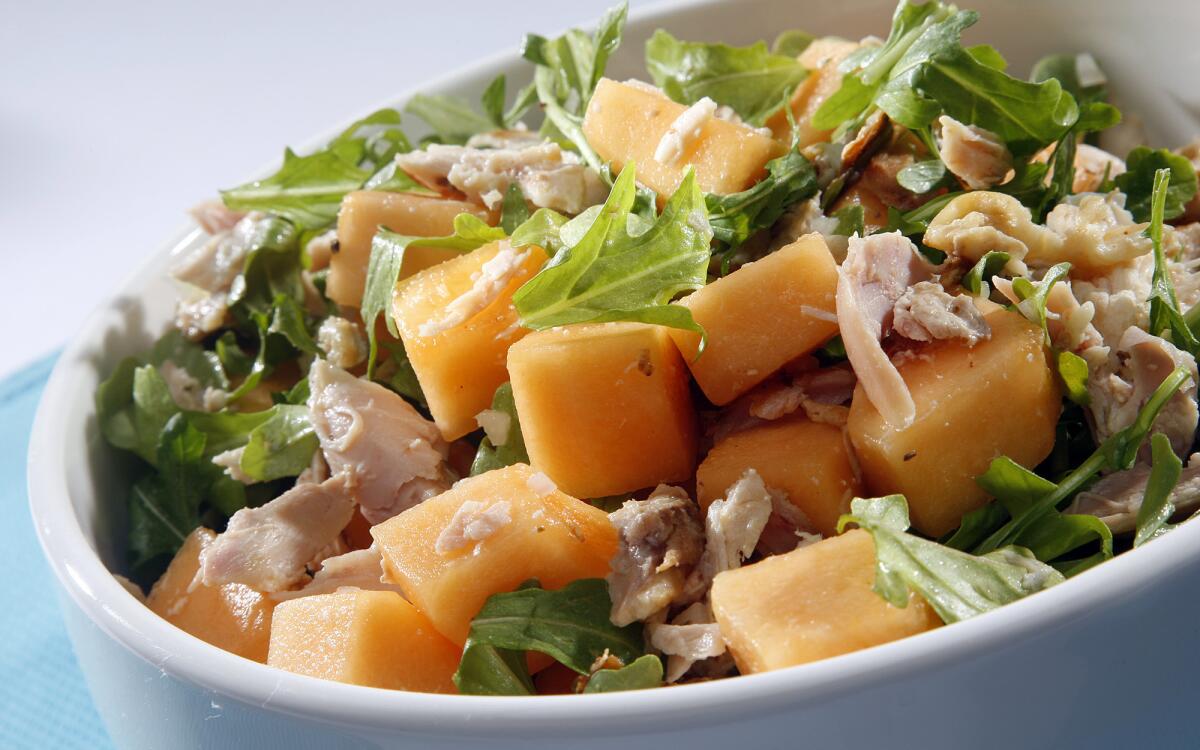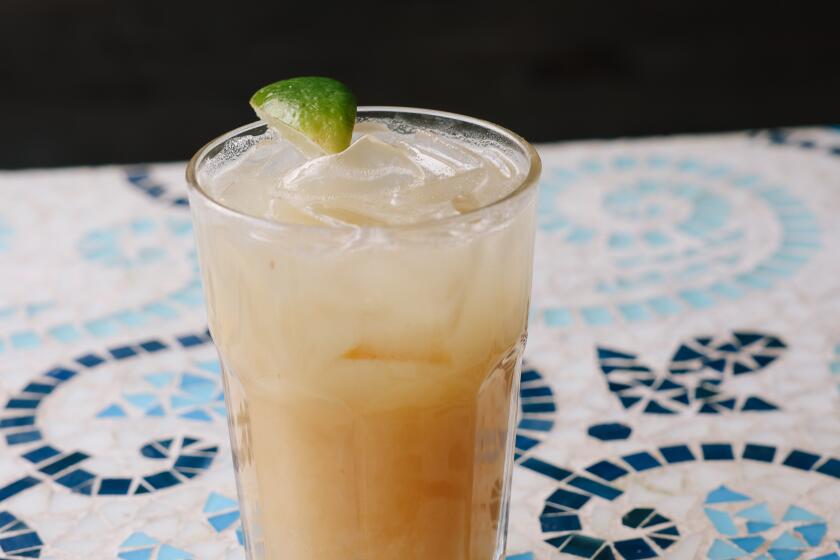Smoked chicken and cantaloupe salad

My dad has never been much of a food guy. I still remember his go-to comfort dish when I was a kid was something he called “bread soup,” which, if I recall correctly, consisted of torn-up white bread soaked in milk. I guess growing up in North Dakota will do that to you.
But when it came to melons, he was way ahead of the curve. Served a wedge of cantaloupe, he’d sprinkle it with salt and pepper. I’ve never seen anyone else do that, but the combination is terrific -- a good melon is way too wonderful to be treated only as a sweet.
There are plenty of traditional examples of this. The most obvious is melon and prosciutto, and a very good one it is: the satin saltiness of the ham playing against the buttery sweetness of the melon. That’s only the beginning of possibilities. I remember well the Thai melon salad Mary Sue Milliken and Susan Feniger used to serve at their old City restaurant, nitro-fueled by fish sauce and chiles.
I’ve been playing with versions of my own recently, mainly because my kitchen counters have been overflowing with melons, so good has this summer’s harvest been.
First, let me say that my experiments have not been unadulterated successes. You can’t just chunk up a melon and throw in a bunch of ingredients and call it a dish. It’s not iceberg lettuce, for goodness’ sake.
For example, though tomato-watermelon salads seem to be everywhere, I have not been able to come up with a combination of my own that really seems to me to be an improvement on either watermelon or tomato by itself.
That’s not to say it can’t be done. I can still recall the taste of a watermelon-tomato salad I had several years ago at the Farmhouse Inn in Sonoma. But no matter what I try, I can’t seem to conjure up whatever magic chef Steve Litke was working that night.
Instead of trying to make the two work together, I just replaced the tomato with watermelon in a Middle Eastern combination with cubed fresh feta. The textural difference is interesting, the watermelon being crisp and somewhat granular rather than the tomatoes’ melting softness.
But what really makes the dish work is the flavor pairing of power with power. The watermelon is so explosively juicy and sweet that you can add all kinds of big tastes -- not just salty feta but also jalapenos! toasted cumin! lime! fresh mint! -- without overwhelming it. In this watermelon salad, the whole is even greater than the sum of its parts, no matter how large they might be.
That’s not to say that the only way to create a melon salad is by making sure every ingredient is screaming at the top of its lungs. Another of my favorites has been the relatively sedate pairing of cantaloupe, smoked chicken and arugula.
Funny thing: I tried many versions of this before finally getting the one that worked the way I wanted. I tweaked the ratios of ingredients, adding more chicken or more arugula. I experimented with different vinegars and oil, and I balanced and re-balanced the dressing. (Because the melon is so juicy, you really need only a fraction of the fat you’d normally use. Also, add the dressing right before serving to keep it from becoming watery.)
It was one of those frustrating exercises in which I could sense that a really great salad was lurking right around the corner just out of my reach. All it needed was one little thing to pull it into focus.
Then I had a flash of inspiration. What about a final, very generous grinding of black pepper? And that did it. Maybe I’ll have to give that bread soup a try after all.
--
The sniff, feel and thump of chosing ripe melons
--
It’s one of summer’s eternal questions: How do you choose a good melon? Though I’ve been working on it for 20 years, I’m still finding my way. The surest solution is to find a great melon man; I buy my fruit from Neil Ims at the Weiser Family Farms stand at the Long Beach farmers market, and he’s never steered me wrong. Failing that, here are some tips:
First, remember that there are three main families of melons, and each has its own markers.
For melons with rough, netted rinds (such as muskmelons and cantaloupes), the best indicator is a powerful perfume; you’ll be able to smell them from a distance. The netting should be raised and the rind underneath should be tan to golden, not green. These melons “slip” from their stems when ripe, so the bellybutton will be clean. Another tip from Ims: On really sweet ones, you’ll see some cracking around the bellybutton.
Smooth-skinned melons (such as honeydews) are harder to choose. There is little or no perfume (their Latin family name is Inodorous). The best clue is a rich, creamy color with a hint of gold, as opposed to gray; also, the surface of the rind will feel slightly waxy as opposed to smooth and polished. If you find a melon that has freckles, buy it: Those are sugar spots.
Watermelons will also have a waxy skin. Look also for a vivid green color and check the couche, the pale spot where it rested on the ground: It should be pronounced and golden. And yes, give a watermelon a thump. It should sound like a hollow-core door.
In a small bowl, combine the shallots and the vinegar, and set aside to steep for at least 5 minutes while you’re preparing the rest of the ingredients.
Combine the chicken and the cantaloupe in a serving bowl, and set aside until ready to serve.
When ready to serve, whisk the oil into the vinegar mixture to make a smooth emulsion. Season with a pinch of salt.
Add the arugula to the chicken and cantaloupe. Pour dressing over the mixture and stir gently to ensure that everything is evenly coated. Finish with a good grinding of freshly ground black pepper to taste.
Get our Cooking newsletter.
Your roundup of inspiring recipes and kitchen tricks.
You may occasionally receive promotional content from the Los Angeles Times.














